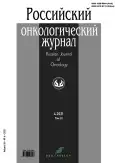Effects of modern antitumor drug therapy possibilities to skin melanoma on oncological and epidemiological indicators in the Krasnoyarsk region
- Authors: Zukov R.A.1, Safontsef I.P.1,2, Klimenok M.P.2, Eremina E.N.1,2
-
Affiliations:
- Professor V.F. Voino-Yasenetsky Krasnoyarsk State Medical University
- Krasnoyarsk Regional Clinical Oncology Dispensary named after A.I. Kryzhanovsky RSBHE
- Issue: Vol 26, No 4 (2021)
- Pages: 111-120
- Section: Clinical investigations
- URL: https://journals.rcsi.science/1028-9984/article/view/107123
- DOI: https://doi.org/10.17816/onco107123
- ID: 107123
Cite item
Abstract
BACKGROUND: Deevelopment of new diagnostics and treatment of malignant neoplasms methods increase their efficiency, and safety is one of the most urgent tasks of modern oncology. Currently, targeted and immunotherapy contributes to the treatment of malignant neoplasms. One of the examples is the treatment of skin melanoma.
AIMS: This study aimed to investigate the influence of therapeutic tactics on epidemiological indicators in the morbidity of the skin melanoma.
MATERIALS AND METHODS: The study used data of the Krasnoyarsk territory cancer-register.
RESULTS: In the Krasnoyarsk territory from 2016 to 2020 registered 65,042 cases of malignant neoplasms, of which 30,532 cases (46.9%) reported among men and 34,510 cases (53.1%) among women. In the same period, registered 899 cases of skin melanoma, 343 cases among men (38.2%) and 556 cases among women (61.8%). The most important stage in the treatment of skin melanoma is the disease stage, because only favorable prognosis characteristic for early stages of the disease.
CONCLUSIONS: Routine using modern antitumor drug therapy in everyday clinical practice has significantly changed the results of skin melanoma treatment.
Full Text
##article.viewOnOriginalSite##About the authors
Ruslan A. Zukov
Professor V.F. Voino-Yasenetsky Krasnoyarsk State Medical University
Author for correspondence.
Email: ethics.commitee@mail.ru
ORCID iD: 0000-0002-7210-3020
SPIN-code: 3632-8415
MD, Dr. Sci. (Med.), Professor
Russian Federation, Krasnoyarsk; KrasnoyarskIvan P. Safontsef
Professor V.F. Voino-Yasenetsky Krasnoyarsk State Medical University; Krasnoyarsk Regional Clinical Oncology Dispensary named after A.I. Kryzhanovsky RSBHE
Email: SIP@onkolog24.ru
ORCID iD: 0000-0002-8177-6788
SPIN-code: 1548-5565
MD, Cand. Sci. (Med.)
Russian Federation, Krasnoyarsk; KrasnoyarskMarina P. Klimenok
Krasnoyarsk Regional Clinical Oncology Dispensary named after A.I. Kryzhanovsky RSBHE
Email: klimenok71@mail.ru
Russian Federation, Krasnoyarsk
Ekaterina N. Eremina
Professor V.F. Voino-Yasenetsky Krasnoyarsk State Medical University; Krasnoyarsk Regional Clinical Oncology Dispensary named after A.I. Kryzhanovsky RSBHE
Email: eremina.catia2010@yandex.ru
SPIN-code: 4132-0336
Russian Federation, Krasnoyarsk; Krasnoyarsk
References
- State report «On the state of sanitary and epidemiological well-being of the population in the Russian Federation in 2020». Available from: https://www.rospotrebnadzor.ru/upload/iblock/5fa/gd-seb_02.06-_s-podpisyu_.pdf. (In Russ).
- Kaprin AD, Starynsky VV, Shahzadova AO., editors. Status of oncological assistance to the population of Russia in 2020 [Internet]. Moscow : MNIOI im. P.A. Gertsena – filial FGBU «NMITs radiologii» Minzdrava Rossii; 2021. (In Russ).
- Gershenwald JE, Scolyer RA. Melanoma staging: American Joint Committee on Cancer (AJCC) 8th edition and beyond. Ann Sur Оncol. 2018;25(8):2105–2110. doi: 10.1245/s10434-018-6513-7
- Gershenwald JE, Scolyer RA, Hess KR, et al. Melanoma staging: evidence-based changes in the American Joint Committee on Cancer eighth edition cancer staging manual. CA Cancer J Clin. 2017;67(6):472–492. doi: 10.3322/caac.21409
- Vakhitova II, Michenko AV, Potekaev NN, et al. The prevalence of risk factors for development of melanoma among dermatological patients. Russian Journal of Clinical Dermatology and Venereology. 2020;19(5):630–636. (In Russ.). doi: 10.17116/klinderma202019051630
- Stang A, Jöckel KH. Does skin cancer screening save lives? A detailed analysis of mortality time trends in Schleswig-Holstein and Germany cancer. Cancer. 2016;122(3):432–437. doi: 10.1002/cncr.29755
- Eremina EN, Karakhanyan AR, Vahraunin DA, et al. Molecular genetic markers of pigment melanoma of the skin (literature review). Siberian medical review. 2020;3:38–46. (In Russ). doi: 10.20333/2500136-2020-3-38-46
- Giunta EF, de Falco V, Napolitano S, et al. Optimal treatment strategy for metastatic melanoma patients harboring BRAF-V600 mutations. Ther Adv Med Oncol. 2020;12:1–15. doi: 10.1177/1758835920925219
- In GK, Poorman K, Saul M, et al. Molecular profiling of melanoma brain metastases compared to primary cutaneous melanoma and to extracranial metastases. Oncotarget. 2020;11(33):3118–3128. doi: 10.18632/oncotarget.27686
- Vanni I, Tanda ET, Spagnolo F, et al. The Current state of molecular testing in the BRAF-mutated melanoma landscape. Front Mol Biosci. 2020;7:[about 16 p.]. Available from: https://www.frontiersin.org/articles/10.3389/fmolb.2020.00113. doi: 10.3389/fmolb.2020.00113
- Shain AH, Yeh I, Kovalyshyn I, et al. The Genetic evolution of melanoma from precursor lesions. N Engl J Med. 2015;373(20):1926–1936. doi: 10.1056/NEJMoa1502583
- Long GV, Flaherty KT, Stroyakovskiy D, Gogas H. Dabrafenib plus trametinib versus dabrafenib monotherapy in patients with metastatic BRAF V600E/K-mutant melanoma: long-term survival and safety analysis of a phase 3 study. Ann Oncol. 2017;28(7):1631–1639. doi: 10.1093/annonc/mdx176
- Robert C, Karaszewska B, Schachter J, et al. Three-year estimate of overall survival in COMBI-v, a randomized phase 3 study evaluating first-line dabrafenib (D) + trametinib (T) in patients (pts) with unresectable or metastatic BRAF V600E/K–mutant cutaneous melanoma. Ann Oncol. 2016;27 Suppl. 6:vi552–vi587. doi: 10.1093/annonc/mdw435.37
- Robert С, Grob JJ, Stroyakovskiy D, et al. Five-year outcomes with dabrafenib plus trametinib in metastatic melanoma. N Engl J Med. 2019;381(7):626–636. doi: 10.1056/NEJMoa1904059
- Long GV, Weber JS, Infante JR, et al. Overall survival and durable responses in patients with BRAF V600-mutant metastatic melanoma receiving dabrafenib combined with trametinib. J Clin Oncol. 2016;34(8):871–878. doi: 10.1200/JCO.2015.62.9345
- Forde PM, Chaft JE, Smith KN, et al. Neoadjuvant PD-1 blockade in resectable lung cancer. N Engl J Med. 2018;378(21):1976–1986. doi: 10.1056/NEJMoa1716078
- Schadendorf D, Hodi FS, Robert C, et al. Pooled analysis of long-term survival data from phase II and phase III trials of ipilimumab in unresectable or metastatic melanoma. J Clin Oncol. 2015;33(17):1889–1894. doi: 10.1200/JCO.2014.56.2736
- Rosner S, Kwong E, Shoushtari AN, et al. Peripheral blood clinical laboratory variables associated with outcomes following combination nivolumab and ipilimumab immunotherapy in melanoma. Cancer Med. 2018;7(3):690–697. doi: 10.1002/cam4.1356
- Postow MA, Callahan MK, Wolchok JD. Immune checkpoint blockade in cancer therapy. J Clin Oncol. 2015;33(17):1974–1982. doi: 10.1200/JCO.2014.59.4358
- Larkin J, Hodi FS, Wolchok JD. Combined nivolumab and ipilimumab or monotherapy in untreated melanoma. N Engl J Med. 2015;373(13):1270–1271. doi: 10.1056/NEJMc1509660
Supplementary files
















